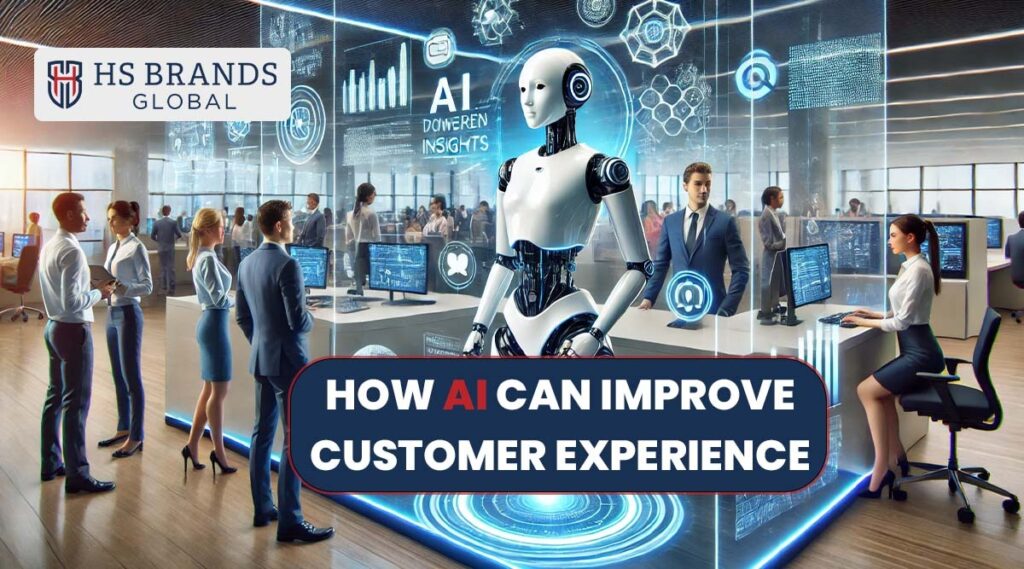Most business leaders nowadays are not required to be convinced of the benefits of artificial intelligence (AI). According to the Zendesk CX Trends Report 2024, 65% of Customer Experience Management leaders regard AI as a strategic imperative that has rendered previous Customer Experience Management (CXM) operations obsolete. Thus, partnering with a reputed Customer Experience Management agency like HS Brands Asia is necessary nowadays for all businesses. Why? Because we leverage AI.
Many firms are still learning to apply advanced AI to improve the buyer experience (CX). Fortunately, we have a few ideas for how you can use AI for CX to create faster and more customized client encounters. Yes, today’s blog will highlight the importance of Customer Experience Management combined with AI in 2025.
Understanding AI in Customer Experience
- An AI CXM is the discipline of using AI technology—like machine learning, chatbots, and a digital Customer Experience Management agency.
- It aims to deliver quick, efficient, personalized, and proactive engagement over time.
- In effect, AI Customer Experience Management leverages technology to enhance client experiences, enhance CX employees’ productivity, and assist the organization in cutting costs.
- AI technology, such as chatbots, machine learning, and generative AI, can be applied throughout the customer journey. They also enable the automation of routine operations, enhance operational efficiency, and create a personalized, dynamic CXM that increases pleasure and loyalty.
- Its ability to browse through unstructured information, employ natural language processing in gathering consumer feedback, and thereafter leverage behavioral intelligence across interconnected networks to redefine the benchmark of customer experience excellence is where it’s true power lies.
Key AI Strategies to Enhance Customer Experience
AI-powered chatbots and Virtual Assistants
The customer service experience on websites and mobile apps has significantly improved with AI chatbots. Offering immediate support via conversational AI enables you to satisfy buyer expectations for prompt, round-the-clock assistance in a world where customers expect responses quickly—ideally within an hour.
Natural language processing-based AI chatbots are trained on your business data to provide accurate and relevant responses to buyer queries. Eighty percent of most support functions can be addressed by AI chatbots, which can also transfer seamlessly to human agents when needed. This enhances Customer Experience Management through responsive and personalised assistance, leaving agents to focus on more complex tasks.
AI chatbots can be merged with support and CRM platforms to:
- Reduce support costs
- Streamline the resolution time.
- Increase CSAT scores and customer satisfaction.
Personalized Recommendations
AI virtual shopping assistants in online stores give personalised suggestions to enable users to find what they’re searching for quickly without having to sift through product lists.
The entire experience and enjoyment of customers are enriched by this level of personalisation, which makes them feel like they are communicating with a friendly assistant instead of a machine.
Predictive Analytics
AI-driven predictive analytics can scan through historical data of consumer interaction, transactions, and engagement to look for trends and patterns. AI can therefore help you predict future customer behaviour and decide on how to improve the client experience in a bid to boost satisfaction and loyalty, such as:
- Demand forecasting
- Determining the most suitable items
- Identifying customer needs
- Trend forecasting
- Avoiding future issues
- Detection of friction within a product’s user experience
Sentiment Analysis
AI for CXM employs Natural Language Processing (NLP) and machine learning to scan user feedback (such as reviews, social media comments, etc.) and identify the sentiment (positive, negative, or neutral) conveyed, allowing companies to know buyer emotions and enhance their Customer Experience Management.
Here’s the explanation in greater detail:
How AI Sentiment Analysis Works
- Data Collection: The AI systems collect text data from different sources such as social media, customer reviews, surveys, and emails.
- NLP and Machine Learning: AI algorithms, having been trained on large databases of human language and emotion, scan the gathered text for keywords, phrases, and patterns that signal a particular emotional tone.
- Sentiment Classification: The AI gives each bit of text a sentiment score or label (positive, negative, neutral, or mixed) so that businesses can know the general customer sentiment
Automated Workflows
Normal tasks such as data entry, email processing, and dealing with recurring questions can be taken care of by AI, freeing up a firm to optimise its operations and focus more on the client’s experience.
You can concentrate on such areas as live assistance, sales, and marketing that require manual attention and expertise. AI reduces the risk of human error to make interactions more precise and effective while releasing staff to focus on higher-value work.
Also Read: Top 10 Customer Experience Strategies to Enhance Consumer Experience
Real-World Applications of AI in Enhancing Customer Experience
-
Case Study: Daily Harvest
Daily Harvest has a mission to deliver nutritious meals to consumers, whose product line runs from heart-healthy harvest bowls to high-protein smoothies. Its meal delivery service started in 2015, ships orders throughout the United States, and retails frozen food products in big-box and supermarket stores like Costco and Kroger, all of which require complex logistics. Though the brand has a wide presence, its team is limited—less than 200 people work for Daily Harvest.
Omnichannel-based business establishment Daily Harvest has incorporated artificial intelligence across operations, as mentioned by Jackson Mlawer, director of product management at the company.
AI is also utilized for making product suggestions, enhancing the user experience, and enhancing packing density. “Last year, we’ve spent a great deal more in hyper-concentrating on places that we understand over the length of our existence as a company have led to success with AI,” Mlawer noted.
AI now plays a role in nearly every corporate function, if not always a controlling one, though discussions often focus on how large companies or Big Tech players leverage it to expand their reach.
Small businesses like Daily Harvest are also using AI, showing how the technology can be employed as a force multiplier.
Challenges and Considerations in Implementing AI
While artificial intelligence (AI) has huge advantages for CX Managers, companies face several issues when implementing these technologies. These issues need to be addressed before AI can reach its full potential.
Technological Challenges
One of the biggest challenges is smoothly incorporating AI systems into existing IT infrastructures.
Most companies use outdated systems that are not designed for AI applications. Implementation often involves huge investments in new technology, as well as changes to existing systems. This can prove to be expensive and time-consuming. Also, companies need specialised IT staff to oversee the implementation and ensure that the systems function correctly and are utilised optimally.
Data Privacy and Security
Processing confidential client information is another major challenge in implementing AI in customer care. AI systems are based on huge amounts of data that need to be gathered, processed, and analyzed to offer personalised and effective solutions. Data security and privacy should always be guaranteed.
Businesses need to ensure that their AI solutions comply with relevant regulatory limitations, for example, the General Data Protection Regulation (GDPR) within the EU. Breach of such rules can attract legal consequences and long-term harm to the customer’s trust. Organisations thus need to utilise robust security features and declare freely how consumers’ information is handled and protected.
Acceptance From Employees and Customers
Alongside technological and legal concerns, there are also human factors to take into consideration when utilising AI. Customers and employees might raise questions about the new technology. Staff might worry that Artificial Intelligence will damage their careers or alter their roles. Consumers, conversely, might be dubious about communicating with a machine instead of a human.
Firms need to take particular actions to solve these problems and create trust. This involves extensive training and change management programs for staff, along with clear communication with consumers. Businesses can encourage adoption and facilitate the transition to AI by clearly explaining its benefits and demonstrating how it enhances service.
How HS Brands Asia Can Transform Your Customer Experience
- By analyzing customer activity, past interactions, and real-time information, HS Brands Asia, with the help of AI, can identify issues before they escalate.
- For instance, AI might alert a missed package or odd account activity and inform the buyer with a fix before they ever know something went wrong.
- That predictive function eliminates the friction that normally happens in regular client service conversations.
Conclusion
Companies that don’t incorporate AI into Customer Experience Management will be left behind as data-driven, personalised experiences become the standard. There are many new AI-based technologies you can use to enhance interactions, gain insights, and integrate AI into your buyer experience.
Ready to leverage AI in revolutionising your buyer satisfaction with the help of our Customer Experience Management agency? Partner with HS Brands Asia now!








